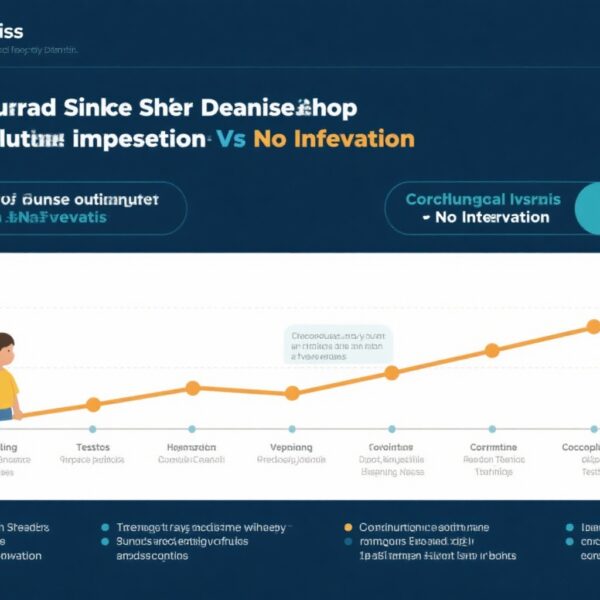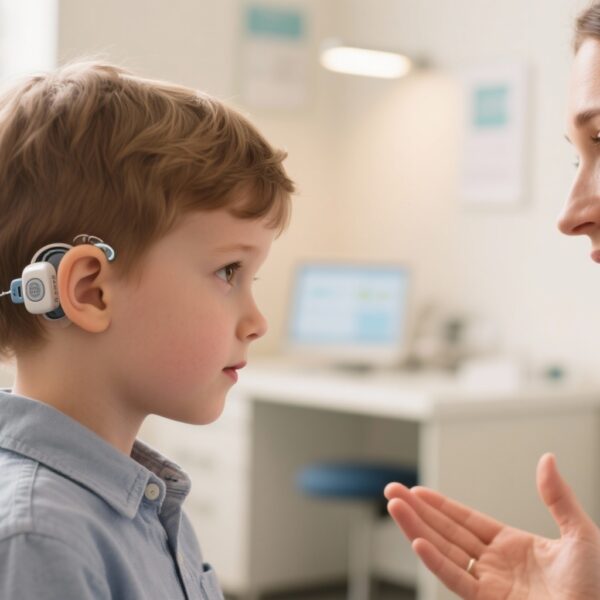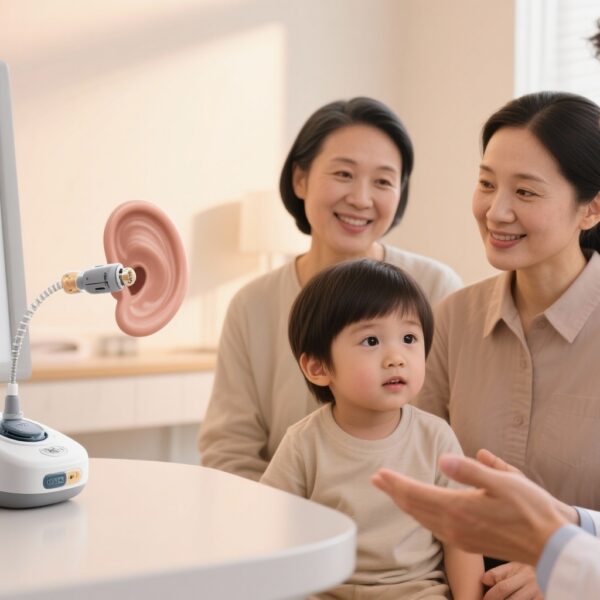Highlight
• In children implanted after short durations of severe-to-profound hearing loss, residual acoustic hearing in the contralateral ear gave better word recognition scores in quiet for single-sided deafness (SSD) than for bimodal (CI + hearing aid) peers, but this advantage was substantially reduced in background noise.
• Speech perception with the cochlear implant alone was similar across groups; bilateral (combined) benefit increased with shorter deprivation and longer CI experience, particularly in quiet.
• Spatial/auditory preference measures aligned with interaural asymmetry: children with SSD favored their acoustic-hearing ear more than bimodal users, and this preference related to CI side and onset timing.
Background
Single-sided deafness (SSD) in childhood interrupts development of binaural hearing, complicates sound localization, and worsens speech understanding in background noise. Historically, clinical options included contralateral routing of signal (CROS) systems or conventional hearing aids when residual hearing exists; more recently, cochlear implantation (CI) in the deaf ear has been used to restore bilateral input and promote binaural processing. Key clinical questions are whether children with SSD derive similar benefit from unilateral CI compared with bimodal device users (CI in one ear and a hearing aid [HA] in the other), how residual hearing in the acoustic-hearing (AH) ear influences outcomes, and which patient factors predict bilateral benefit.
Study design
This observational cohort study included 185 children who received a unilateral CI after relatively short durations of severe-to-profound hearing loss (median deprivation 1.9 years, IQR 1.0–2.9). Median age at implantation was 5.3 years (IQR 3.1–10.6). The cohort comprised 43 children with SSD (normal hearing contralateral ear) and 142 bimodal users whose contralateral ear had mild-to-moderately severe (n = 39; PTA median 48.8 dB HL) or severe-to-profound hearing loss (n = 103; PTA median 80.0 dB HL).
Speech perception was evaluated using word recognition tests in quiet (n = 182; mean 2.8 sessions/child) and in co-located speech-weighted noise at +10 dB SNR (n = 109; mean 2.0 sessions/child). Spatial release of masking (SRM), a measure of benefit from spatial separation of target and masker that indexes spatial/binaural processing and ear preference, was obtained in a subset (n = 78; mean 1.6 sessions/child). Scores were reported in rationalized arcsine units (RAU) to stabilize variance for percent-correct data. Analyses compared AH ear, CI-alone, and bilateral performance across groups and examined predictors including duration of deprivation, CI experience, onset (pre- vs post-lingual), and implant side.
Key findings
1. Acoustic-hearing ear advantage in quiet, reduced in noise
In quiet, children with SSD outperformed bimodal device users when listening with the AH ear (p < 0.001). This is expected because SSD children typically have near-normal thresholds in the AH ear, whereas bimodal peers often have measurable loss that limits unaided performance. However, in +10 dB SNR noise the group differences narrowed because the SSD group showed a marked decline in AH-ear performance in noise (mean difference between quiet and noise = 27.3 RAU, SD 2.6; p < 0.001). In short, a normal or near-normal acoustic ear can handle quiet listening well, but noise exposes binaural processing needs that a single acoustic ear cannot fully meet.
2. CI-alone performance similar across groups
When tested with the CI alone, word recognition scores did not differ significantly among SSD children and the two bimodal subgroups (p > 0.05) in either quiet or noise. This suggests that the implanted ear’s contribution to monosided speech perception is comparable irrespective of contralateral residual hearing level, at least in this pediatric cohort and with the tested devices and experience ranges.
3. Interaural asymmetry and bilateral benefit
Interaural asymmetry (AH ear minus CI ear performance) in quiet favored the AH ear in SSD children (mean 30.7 RAU, SD 29.1), whereas bimodal users were asymmetric toward the CI ear (mean asymmetry −5.25 RAU for mild-to-moderate HL and −27.2 RAU for severe-to-profound HL), reflecting greater relative CI benefit when the acoustic ear is impaired. The measured bilateral benefit (performance with both ears vs better ear alone) was smallest in the SSD group in quiet (p < 0.01), indicating smaller incremental gains from adding the CI to an already good acoustic ear in quiet listening conditions.
In noise, between-group differences in asymmetry and bilateral benefit were less pronounced; statistically significant contrasts were observed only between SSD and the severe-to-profound bimodal subgroup (p = 0.02 for interaural asymmetry; p = 0.03 for bilateral benefit). This underscores that noise conditions differentially reveal the value of bilateral input and can reduce apparent advantages of a normal acoustic ear.
4. Predictors: deprivation duration and CI experience
Shorter durations of auditory deprivation before implantation and longer CI experience predicted reduced asymmetry toward the AH ear and larger bilateral benefit in quiet (p < 0.01 and p = 0.01, respectively). These effects were not observed in noise. The findings support a developmental and plasticity interpretation: earlier restoration of input to the deaf ear and sustained bilateral stimulation promote more symmetric performance and greater integration of CI input into everyday listening.
5. Spatial/auditory preference consistent with performance asymmetry
Spatial release of masking (SRM) data, indexing spatial separation benefits and ear preference, correlated with interaural asymmetry in quiet (p = 0.01). Children with SSD showed larger preference for the AH ear compared with bimodal peers (p < 0.01). Aural preference was also greater for children with post-lingual onset of deafness who received a left-sided CI rather than right-sided (p = 0.04), an intriguing lateralization effect that may relate to handedness, linguistic laterality, or clinical selection bias and warrants further study.
Clinical interpretation and implications
This study provides clinically actionable insights for counseling families and planning management for children with unilateral severe-to-profound loss considering CI. Key messages:
• Expectation setting: For children with SSD who retain near-normal contralateral hearing, the acoustic ear will often deliver excellent quiet speech recognition; therefore, bilateral benefit from adding a CI may be modest in quiet but more meaningful in noisy, real-world settings where binaural processing aids speech segregation and localization.
• Timing matters: Shorter durations of deafness before implantation and longer CI experience were associated with more symmetric performance and greater bilateral benefit. Early evaluation and timely implantation should be discussed as a strategy to maximize auditory development and binaural integration.
• CI-alone is robust: Similar CI-alone performance across groups implies that outcomes from the implanted side are not substantially determined by the degree of contralateral residual hearing — a useful point when comparing expected outcomes among SSD and bimodal candidates.
• Rehabilitation focus: Because the SSD group showed marked declines in noise with the AH ear and smaller bilateral gain in quiet, rehabilitation should emphasize real-world listening skills, spatial hearing training, and optimizing device programming and hearing-aid fittings for bimodal users to maximize complementary input.
Expert commentary and limitations
The study by Bartels et al. (Ear Hear. 2025) adds valuable, relatively large-cohort data to the pediatric SSD literature. Strengths include a sizeable sample, subgroup analyses by contralateral hearing status, and objective measures of spatial benefit. Nevertheless, limitations deserve consideration when applying findings:
• Observational design: As a non-randomized cohort, selection biases and unmeasured confounders (e.g., etiology, cognitive factors, rehabilitation intensity, hearing-aid fitting quality, socioeconomic factors) may influence outcomes.
• Outcome measures: The primary endpoints were word recognition in quiet and at a single SNR (+10 dB). Real-world listening involves a range of SNRs and complex maskers; additional measures (sentence tests, localization tasks, ecological assessments) would enrich interpretation.
• Heterogeneity: The bimodal group included a wide range of contralateral thresholds; degree and configuration of residual hearing, HA usage consistency, and aided audibility were not fully detailed in the summary but are important moderators of bimodal outcomes.
• Follow-up duration and device era: Median age at implantation was 5.3 years, but individual CI experience varied; longer-term follow-up is needed to understand developmental trajectories. Advances in CI processing and HA technology over time can influence outcomes in multi-year cohorts.
Research and practice gaps
Important next steps include prospective, longitudinal studies that pair objective audiologic tests with functional real-world outcomes (academic performance, spatial hearing in classrooms, quality-of-life measures). Studies comparing early CI in SSD to amplified contralateral strategies with standardized HA fittings would help refine indications. Optimization of bimodal fitting protocols to promote binaural fusion and reduce interaural asymmetry merits investigation. Finally, neurophysiological and imaging studies could delineate cortical plasticity patterns related to timing of implantation and bilateral experience.
Conclusion
Bartels and colleagues report that unilateral cochlear implantation provides measurable benefits for children with SSD and for bimodal device users, but patterns vary by listening condition and by timing. While the acoustic ear often dominates in quiet for SSD children, noise reveals the need for bilateral input; earlier implantation and longer CI experience attenuate asymmetry and enhance combined-ear benefit. These findings support active consideration of CI for pediatric SSD with early referral and individualized counseling about expected benefits in quiet and noise.
Funding and clinicaltrials.gov
Funding and trial registration details were not provided in the summary supplied here. Please consult the original publication for full disclosures: Bartels H, Polonenko MJ, Negandhi J, Alemu R, Cushing SL, Papsin BC, Gordon KA. Ear Hear. 2025 Oct 23. doi: 10.1097/AUD.0000000000001723. PMID: 41128525.
References
1. Bartels H, Polonenko MJ, Negandhi J, Alemu R, Cushing SL, Papsin BC, Gordon KA. Speech Perception Outcomes in Children With Single-Sided Deafness Receiving Unilateral Cochlear Implantation Compared to Bimodal Device Users. Ear Hear. 2025 Oct 23. doi: 10.1097/AUD.0000000000001723. Epub ahead of print. PMID: 41128525.
2. American Academy of Otolaryngology—Head and Neck Surgery Foundation. Clinical Practice Guideline: Cochlear Implants. Otolaryngol Head Neck Surg. 2019;160(1_suppl):S1–S42.
AI thumbnail prompt
Photorealistic image of a young child sitting on a clinician’s lap in an audiology clinic, a cochlear implant visible behind the ear, an audiogram and speech-in-noise waveform faintly overlaid in the background; warm, reassuring lighting, clinical but human-focused composition.






